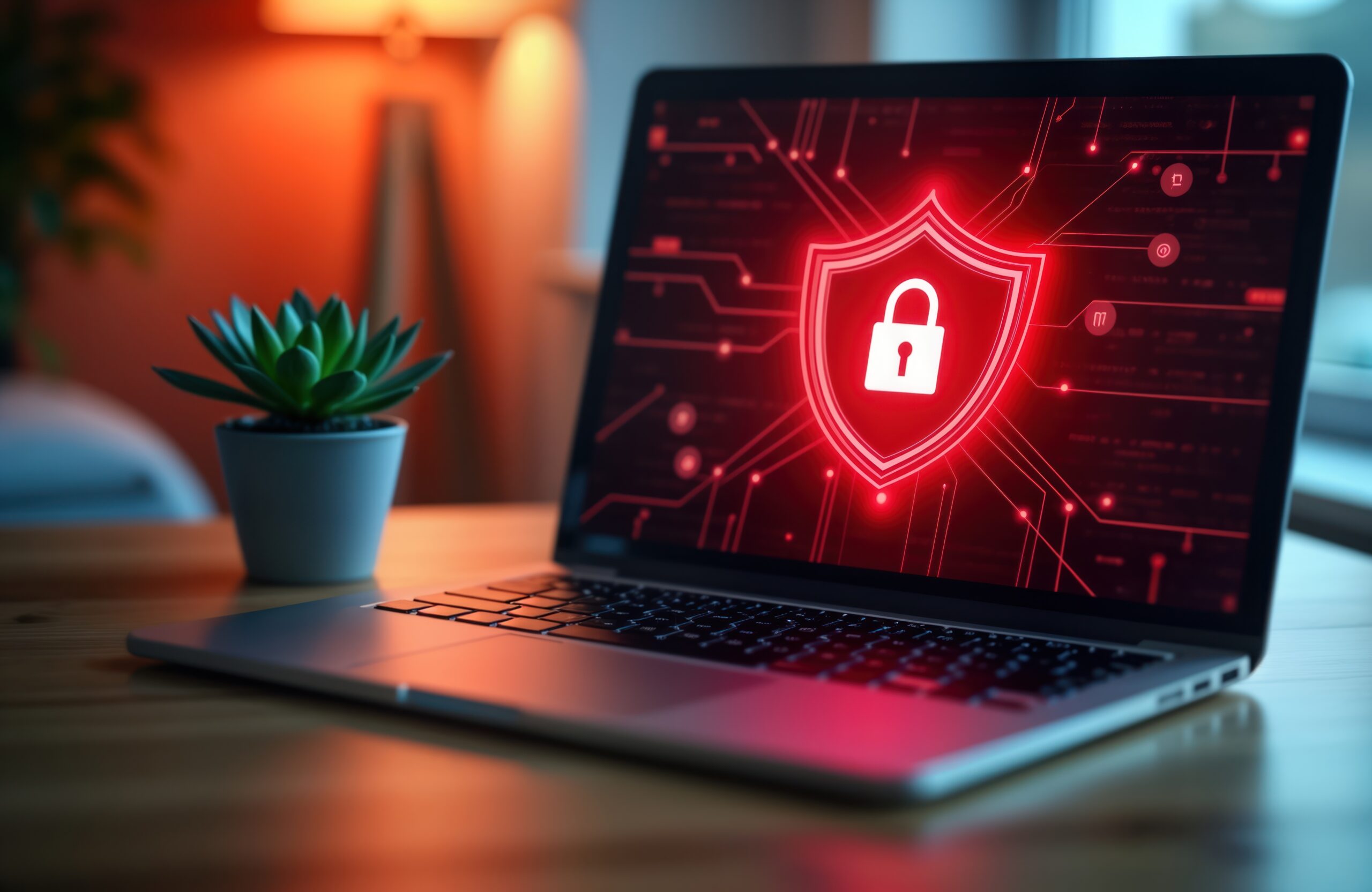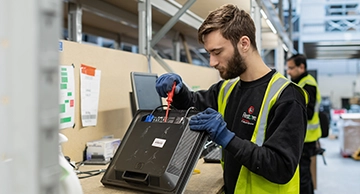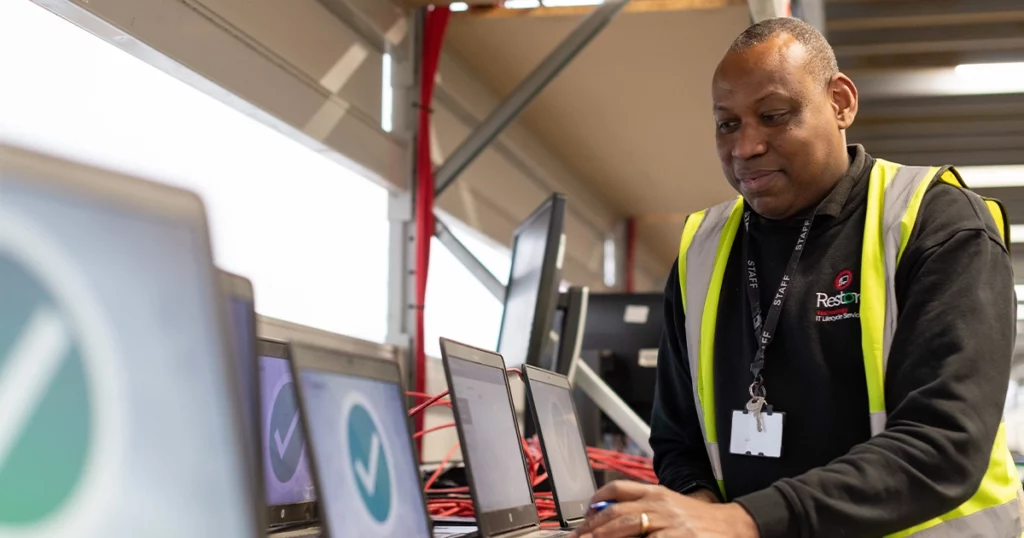In the modern world, IT assets underpin nearly every aspect of a business’s operations.
From desktops and servers to cloud applications and mobile devices, these resources are critical to achieving operational efficiency, data security, and compliance. However, effectively managing these assets is no simple task. This is where IT Asset Management (ITAM) steps in.
At Restore Technology we understand how crucial transparent, secure, and sustainable solutions are to a business’s IT asset lifecycle services. Whether you’re looking to maximise the value of your IT assets or enhance your organisation’s security posture, a well-structured ITAM strategy is essential. In this definitive guide, we’ll explore everything from the fundamentals of ITAM to best practices and emerging trends.

What is IT Asset Management (ITAM)?
In its simplest form, IT Asset Management (ITAM) is the process of tracking and managing an organisation’s IT assets throughout their lifecycle – from procurement and deployment to maintenance, retirement, and disposal. This includes both tangible assets like laptops and servers and intangible assets such as software licenses and cloud subscriptions. According to the International Association of IT Asset Managers, ITAM is a set of business practices that join financial, contractual, and inventory functions to support lifecycle management and strategic decision-making for the IT environment.
Find out moreWhy is ITAM So Important?
The need for IT Asset Management (ITAM) is more urgent than ever. As businesses adopt hybrid work models and face heightened security threats, managing IT assets has become a foundational requirement.
The core objectives of ITAM are centred on optimising asset value, improving security, ensuring compliance, and promoting sustainability. Let’s break them down:
- Cost efficiency: By knowing what you own and how it is used, you can reduce unnecessary purchases, avoid duplicate assets, and lower operational costs.
- Security: ITAM strengthens your cyber resilience by ensuring all assets are accounted for, regularly updated, and securely decommissioned.
- Compliance: Regulatory bodies such as the ICO (Information Commissioner’s Office) require organisations to protect sensitive data. ITAM plays a vital role in GDPR compliance by ensuring data is securely handled throughout an asset’s lifecycle.
- Sustainability: By extending the life of IT assets through remarketing and recycling, ITAM helps organisations contribute to a greener economy.

What is the ITAM Lifecycle?
The IT asset lifecycle is like the life story of every piece of technology your business uses, from the moment you buy it to the day it’s retired or repurposed.
Restore Technology helps businesses manage all these stages smoothly, making sure assets stay secure, sustainable, and cost-effective throughout their lifecycle. Understanding this helps businesses make sure their technology is always useful, secure, and well-managed – regardless of IT depreciation.
Find out moreThe stages of an IT asset’s life:
- Planning and Procurement: This is where you figure out what tech your business needs—whether it’s laptops, servers, or software—and purchase them.
- Deployment: Once bought, assets are set up and handed out to the right people in your organisation.
- Maintenance and Monitoring: This step is all about regular check-ups—keeping things updated, fixing issues, and making sure everything is working safely and smoothly.
- Usage/Operation: This is when staff use the equipment for their daily tasks. Whether working in the office or remotely, this stage could last years depending on the asset.
- Decommissioning: Eventually, equipment becomes outdated or no longer needed. This step is about safely removing it from active use.
- Reusing or Recycling: Finally, old equipment is either securely recycled, sold on, or reused in another part of the business.
What Are the Benefits of ITAM?

ITAM empowers organisations to manage their IT budgets more intelligently. By providing a clear overview of what assets you own and how they are used, you can make informed decisions about resource allocation. This reduces unnecessary purchases, helps renegotiate vendor contracts, and identifies underutilised or redundant assets that can be repurposed or retired. In practice, this means your organisation avoids waste, optimises spend, and builds a more resilient financial strategy.

With cyber threats escalating, knowing exactly which assets are on your network is essential. A comprehensive ITAM system ensures that every asset – from servers to software licenses – is accounted for, patched, and monitored. This reduces vulnerabilities and helps IT teams respond swiftly to emerging threats. ITAM also helps eliminate rogue devices or shadow IT, creating a safer digital environment for your business and customers.

Compliance isn’t optional, especially in industries where customer data and intellectual property are at risk. ITAM makes adhering to regulations such as GDPR, ISO 27001, and PCI DSS much more straightforward by enabling accurate asset tracking and documentation. This facilitates smoother audits, reduces legal risks, and reinforces customer trust.

Sustainability is no longer a nice-to-have – it’s a business imperative. ITAM helps organisations reduce their environmental footprint by supporting responsible asset lifecycle management. Whether through recycling, refurbishment, or resale, services like ours helps businesses extend asset life and avoid contributing to landfill. These efforts not only support Corporate Social Responsibility (CSR) commitments but also strengthen your brand’s reputation as an environmentally responsible leader.

What Are the Risks and Challenges Associated with ITAM?
While ITAM brings a wealth of benefits, it is not without its hurdles. Many organisations encounter stumbling blocks that can impact efficiency, security, and compliance. Recognising these risks early allows for proactive mitigation.
Common ITAM Challenges and How to Overcome Them:
1. Data Inaccuracy
Keeping track of hundreds or thousands of assets manually is a recipe for errors. Spreadsheets get outdated, serial numbers go missing, and soon enough, you have blind spots in your asset inventory.
Solution: Modern businesses are turning to automated ITAM solutions that give real-time visibility into asset usage, location, and status. With automation, data accuracy is vastly improved, enabling confident decision-making and tighter controls.
2. Shadow IT
Employees often introduce unauthorised devices or software to the network in an effort to boost productivity. While usually well-intentioned, shadow IT can open the door to cybersecurity vulnerabilities, licensing issues, and data breaches.
Solution: Foster a collaborative culture between IT and other departments. Centralising procurement processes, educating employees on potential risks, and scheduling regular asset audits can significantly reduce unauthorised IT activity.
3. Lack of Integration
Siloed systems are one of the most common barriers to effective asset management. When ITAM isn’t integrated with your service desk or procurement platforms, data becomes fragmented, leading to inefficiencies and missed insights.
Solution: Integration is key. By aligning ITAM with ITSM, ERP, and financial systems, organisations create a unified ecosystem where data flows seamlessly, enabling end-to-end visibility and streamlined workflows.
4. Resource Constraints
For SMEs or fast-growing businesses, dedicating full-time personnel to manage IT assets might be out of reach. This can lead to stretched teams, overlooked compliance issues, or inefficient asset utilisation.
Solution: Consider engaging a trusted partner like Restore Technology. With scalable solutions and specialist expertise, Restore can act as an extension of your team – helping you manage assets securely, efficiently, and in line with your organisation’s goals.

Making it Work: Processes and Procedures
ITAM processes are the everyday actions that bring your strategy to life. They’re designed not just to manage assets – but to create a smoother, safer, and more cost-effective workplace.
Some of the key processes include:
Asset discovery and inventory management: Think of this as your master list – knowing what you own, where it is, and how it’s performing.
License compliance verification: Checks whether your software estate is fully compliant, reducing financial and legal risks.
Asset tagging and labelling: Clear and consistent labelling makes life easier for your IT team and reduces the chance of assets going missing.
Regular audits and reporting: Regular touchpoints keep your inventory accurate, drive accountability, and highlight opportunities for improvement.
Secure decommissioning and data destruction: When assets reach end-of-life, they’re retired safely and sustainably, protecting sensitive data and the planet.


Why It Matters
When ITAM is done well, it boosts more than just efficiency and compliance – it enhances collaboration and helps organisations meet their sustainability goals. With a people-first approach, ITAM can transform from a background process into a core contributor to your success. At Restore, we believe ITAM is about people as much as it is about technology. And when those two worlds come together, possibilities are endless. By weaving best practices into your day-to-day operations, ITAM becomes more than a process – it becomes part of your organisation’s DNA, helping you build a more secure, and sustainable future.
Best Practices for ITAM in an Organisation

Embrace automation to simplify and enhance asset management. Automating asset discovery, tagging, and tracking ensures accuracy while freeing your team to focus on strategic tasks. Think of it as giving your staff the gift of time and confidence in the data they rely on.

Your ITAM strategy should mirror your organisation’s broader goals – whether that’s driving down costs, improving operational resilience, or achieving sustainability targets. By making ITAM a core component of your business strategy, you create alignment across teams and encourage buy-in from leadership.

Routine audits foster accountability and uncover hidden issues, such as unauthorised assets or underutilised equipment. Regular check-ins can also open dialogues between IT and other departments, reinforcing a shared sense of responsibility for your technology environment.

Your ITAM system shouldn’t operate in isolation. By connecting it to your IT Service Management (ITSM), ERP, and cybersecurity platforms, you can create a seamless ecosystem that brings clarity and unity to asset management.

Every asset has a lifecycle. Planning for secure, responsible, and eco-friendly disposal from the outset helps avoid costly surprises later. Restore Technology’s end-of-life services make absolutely data is destroyed securely and assets are recycled or remarketed, giving them a second life.

ITAM works best when it’s championed across all levels of the organisation. From onboarding sessions to refresher workshops, equip your teams with the knowledge to manage assets responsibly. Engaged employees who understand the “why” behind ITAM are more likely to contribute positively to its success.
Managing IT Assets Responsibly
Navigating the complexities of IT asset management can be a challenge, but with the right strategy and support, it becomes a powerful driver of efficiency, security, and sustainability.At Restore Technology, we take a people-centred approach to IT asset lifecycle services. From secure data destruction to remarketing and recycling, we help businesses unlock value and reduce environmental impact. If you’re ready to take control of your IT assets and future-proof your operations, speak to our experts today.
Contact Us


